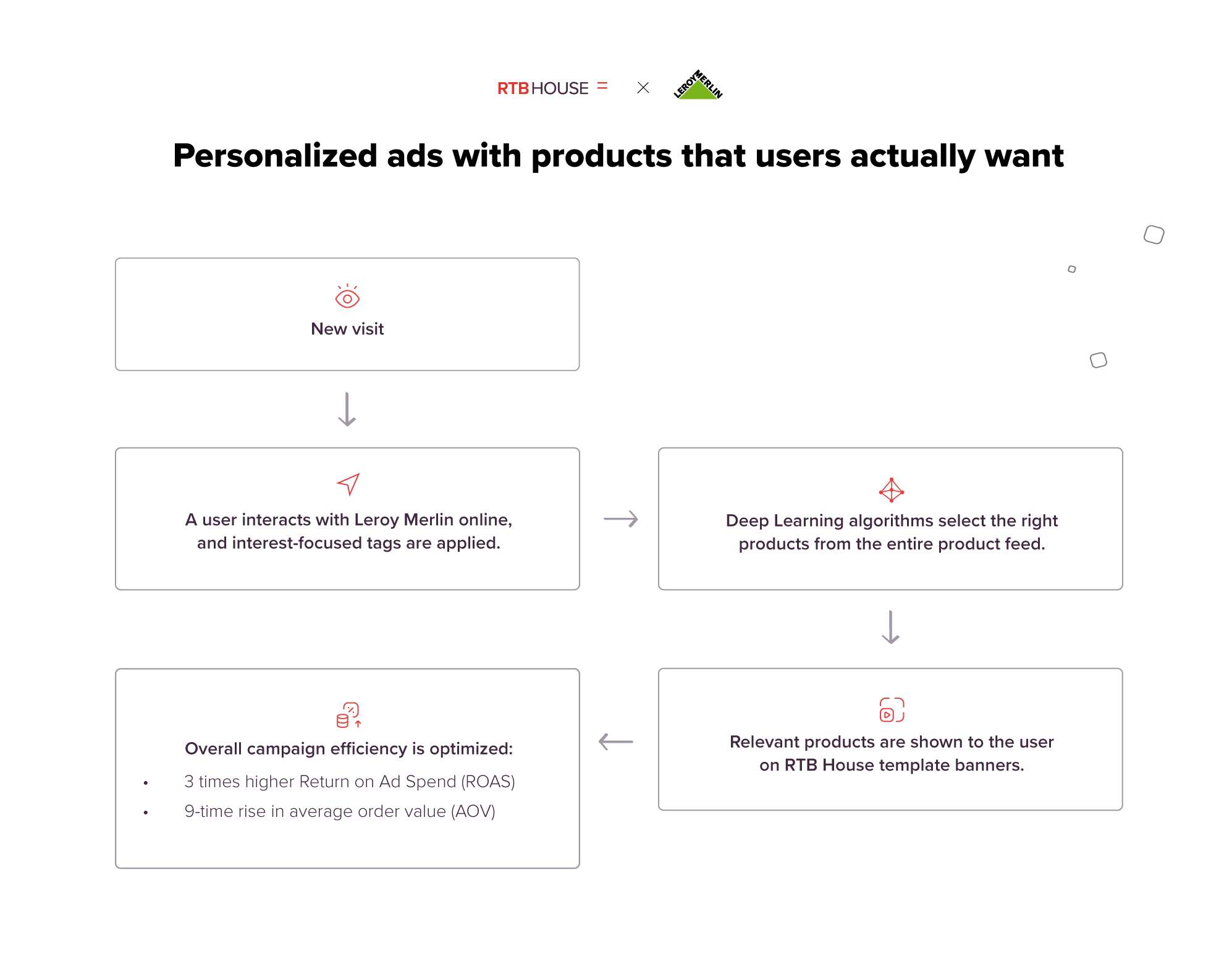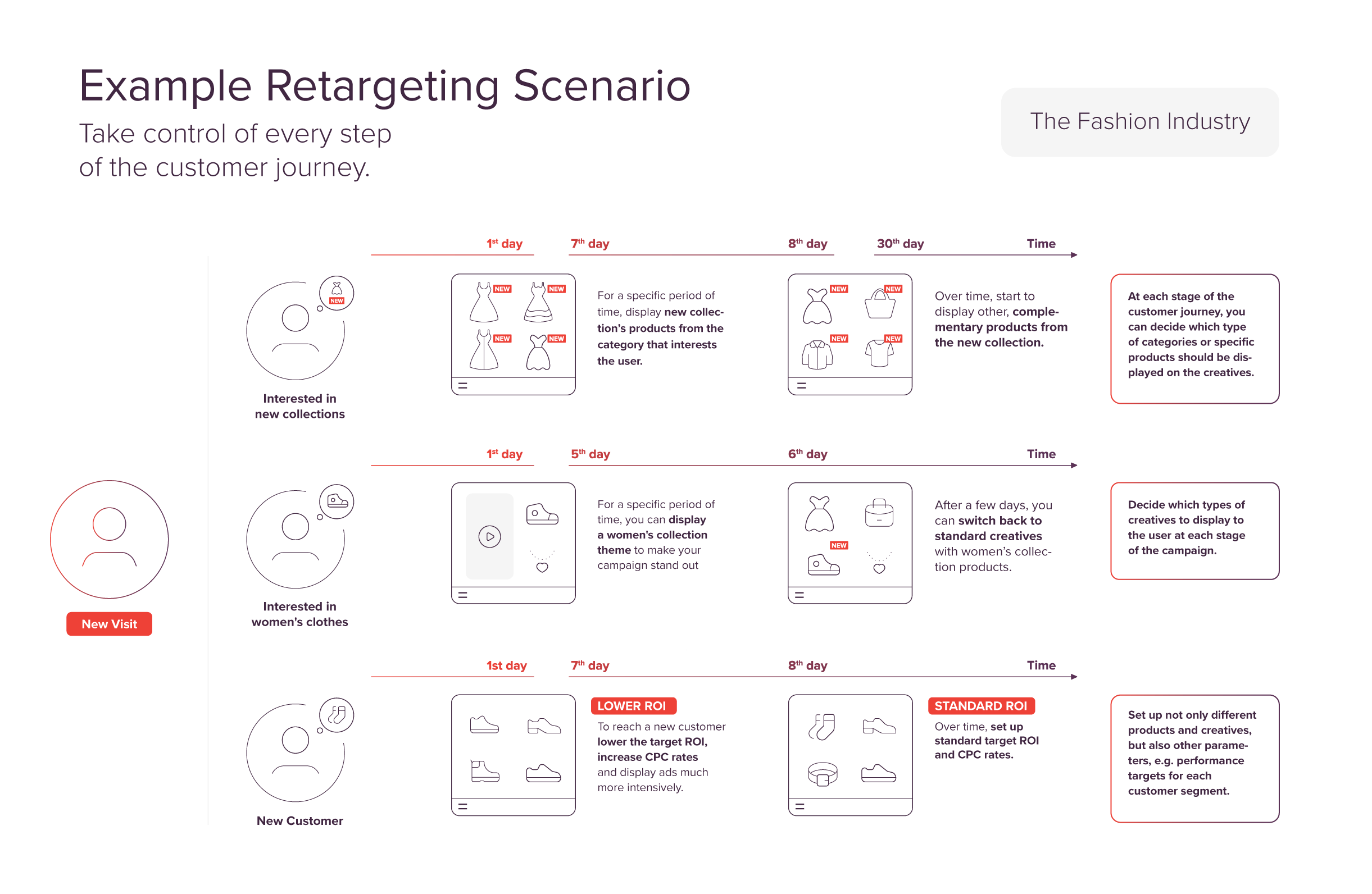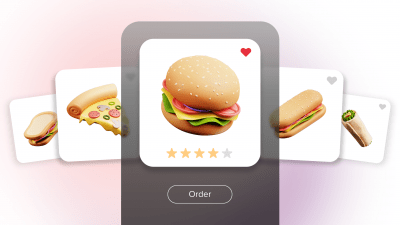Last Updated on: 26th May 2024, 08:03 pm
When many of us think of retargeting, our minds jump immediately to simple banner ads showing off the exact products that have been on our minds—but retargeting is so much more than that. With the right data and technology, we can use retargeting to connect with very specific types of users, or to achieve sophisticated goals. To understand why, let’s take a look at some retargeting ad examples and what they tell us about retargeting in general.
In this article, you will learn:
- How retargeting works.
- When to use retargeting.
- How flexible retargeting campaigns can be (with retargeting ad examples).
Table of Contents:
- What is retargeting, and how does it work?
- #1 Using preferences and predicted interests to show personalized ads to users with products they actually want
- #2 Boosting promo period sales with retargeting
- #3 Driving first-time buyers to your brand
- #4 Using in-app retargeting to bring lapsed users back to mobile gaming apps
- #5 Using retargeting to boost inquiries for big-ticket items
- #6 Combining aesthetics with practical applications
- The secret to a successful retargeting campaign? Deep Learning
- Find out how you can use retargeting to meet your revenue goals
What is retargeting, and how does it work?
Before we jump into some examples of retargeting ads, it’s worth quickly covering what retargeting is, how it works, and how we use it.
Retargeting is a marketing method used to reconnect with customers who have shown interest in your website or product. This could be any type of user who visited your website or app, from those who browsed without engaging in significant actions, to shoppers who added products to their basket but did not finalize a purchase, as well as actual buyers.
Retargeting ads share a specific message with a user based on their perceived interests. This might be a product category that they’ve engaged with on your website or a particular aspect of a product that the user might be interested in. There are many ways to utilize this sort of data, and Demand Side Platforms (DSPs) like RTB House will have their own internal technologies to make the most of it. In our case, we use Deep Learning to drive deeper insights.
Retargeting is a long-term strategy with short-term use cases that is designed to build lasting relationships with customers and ultimately entice them to convert. Used properly, retargeting can have a significant positive impact on your bottom line.
However, this is just scratching the surface of what’s possible with retargeting. Let’s dive into some specific retargeting ad examples and discover just how flexible this marketing strategy can be.
#1 Using preferences and predicted interests to show personalized ads to users with products they actually want
Whenever a user interacts with a website, they provide the website owner with valuable information about their interests and, most importantly, what products they are in need of right now. With the right technology, for example, the Deep Learning algorithms used by RTB House, it is possible to very accurately predict what a user would be interested in and build personalized adverts specifically tailored to that user or group of users.
A great example is RTB House’s campaign for Leroy Merlin, a leading French omnichannel retail brand in DIY and home improvement. Leroy Merlin has a huge range of products that they can showcase, and that’s absolutely perfect for retargeting.
So how does it work? Well, users with certain interests are more likely to be interested in specific products or groups of products. We were able to use Deep Learning to identify a user’s predicted interests and show them products they were more likely to purchase. This approach was successful, with a three times higher Return on Ad Spend (ROAS) and a nine times rise in the average order value.

This approach represents the most straightforward way that brands can implement retargeting and represents a cost-effective way to boost revenue quickly.
#2 Boosting promo period sales with retargeting
One overlooked aspect of retargeting is the ability to use timing to your advantage. This can be a particularly powerful tool for brands looking to take advantage of promo periods like Black Friday. During sales periods, shoppers are significantly more likely to make a purchase, with our Black Friday & Holiday Season Report showing that conversion rates significantly increase across a broad selection of markets during the holiday sales season.

This represents a huge opportunity, but every other brand is alpso chasing it, which means that you need to work harder to capture user attention, and that’s where Retargeting can be key.
The most effective way to boost promo period sales is actually to start well before the promotional period begins. By remembering what products a user was interested in prior to a sale or from previous purchases, you can use promotional periods to help push them over the finish line and convince them to make a purchase.
This approach can be hyper-effective. Take the example of Westwing, which was able to use a clever retargeting strategy to boost Black Friday revenue by 81% year-on-year. The key was to deliver tailored creatives to users that highlighted promotions they were likely to love, thus improving conversion rates and maximizing the potential of the holiday sales.
Westwing isn’t the only example. We were able to use similar methods to help luxury retailer Neiman Marcus achieve a 26% increase in sales revenue, which is no easy task in the luxury goods space. RTB House’s performance in the campaign was strong enough to secure an exclusive partnership with Neiman Marcus to operate as their sole retargeting provider for the holiday period.
#3 Driving first-time buyers to your brand
Retargeting isn’t just about converting existing customers; it can also be a powerful tool to entice people into becoming first-time buyers. How does this work? Well, first, a user visits your website, but they’ll probably fall into the 97% of users who leave without making a purchase. Retargeting is how you bring them back.
Even if a user only browsers a website, the way they interact with the site still provides enough insights to take a good guess at what they’re going to be interested in. For example, if they spent most of their time looking at sneakers, you can be pretty sure they’re in the market for a new pair of shoes. Retargeting partners can use this information to create ads that help to remind a user that your website is a great place to get what they’re looking for, and this will help them feel more comfortable returning to your store.

However, this is just the beginning. In the past, a simple approach like this worked. Today’s market is so competitive that all serious retargeting partners, including RTB House, leverage technology to streamline this process. For example, Deep Learning algorithms can determine more precise insights about a specific user’s preferences; for example, it might realize that the user is only looking at Adidas brands, and this gives you the opportunity to show the best Adidas sneakers and upsell that user with other Adidas sports products.
Does it work? Yes! RTB House was able to help Turkish delivery service Yemeksepeti hit their first-time order targets and boost revenues. The key was to combine Deep Learning algorithms with creatives tailored to each user’s unique tastes, some pun intended. This was done by combining existing user data with further insights gathered over the course of the ten-month campaign with Yemeksepeti. For example, if a user had expressed interest in spicy Thai food, we could also display ads for other cuisines with spicy dishes.
#4 Using in-app retargeting to bring lapsed users back to mobile gaming apps
So far, we’ve been focusing on the idea of sales, but retargeting can also be used to help boost engagement with mobile apps. For all mobile apps, engagement is key, whether we’re measuring that by stickiness, average retention, or the percentage of paying users. Users have so many options that if they stop using an app, they’re likely gone for good. For those who are curious, this is exactly why Duolingo pressures you so hard to keep completing your lessons. If you drop the habit, it’s really hard to get you to pick it up again.
There are a number of methods that apps use to keep you engaged, including push notifications, but in-app and mobile retargeting also enables you to connect with users while they are engaged in another app. It’s an approach that can feel less intrusive than push notifications or emails and provides a way to reconnect with users.
This approach is particularly effective if you leverage it the way that Boombit did. The company wanted to encourage users to return to their game, Hunt Royale. The multiregional campaign focused on bringing lapsed users back into the game and encouraging them to make a purchase.
To achieve this, RTB House rotated a series of compelling creatives designed to combat ad fatigue and carefully analyzed rich data to determine how factors like location impacted a user’s response to a particular creative or in-app placement. This resulted in a campaign that not only generated more operations, which led to a purchasing decision, but also had a 3.6 times shorter payback time compared to other channels, improving Boombit’s revenue flow.
#5 Using retargeting to boost inquiries for big-ticket items
So far, our retargeting ad examples have focused mostly on smaller ticket items, like food, shopping, or video games, but it can also be used to help sell big purchases. When a user is looking at buying something big, like a car, the consideration process is often significantly longer, but retargeting can play a hugely important role in helping to get customers into a dealership for a test drive.
As more diverse vehicles have become available, retargeting offers a way to show users what is on offer and pair them with their perfect ride. This could be about helping a new family find the perfect SUV for the school run or an eco-conscious customer decide whether a hybrid vehicle is a good fit for their needs.
This approach is often most valuable to companies that aggregate various car sales listings. These platforms have a wide array of vehicles on offer, and that level of choice can be overwhelming for customers when they do their research. Retargeting can reconnect with them and keep the conversation going.
RTB House regularly works with auto companies to help get the news about their car out there. For example, we helped car search portal Motors.co.uk boost leads by seven times with retargeting.
The key was to leverage deep market segmentation to determine exactly what kind of vehicle a user was likely to be interested in. This enabled us to deliver highly personalized ads that encouraged users to become leads, which would hopefully result in an eventual sale.
#6 Combining aesthetics with practical applications
A key success factor for retargeting is the visual aesthetic of the banners. The right style of aesthetic can be key to converting window shoppers into customers. With the right application of technology, there are plenty of ways to do this.
For example, you can take the same aesthetic and product lines to produce a wide variety of banners, at least one of which will resonate with every one of your customers. In some cases, customers may be familiar with your brand but not specific product lines, so a dedicated banner can put your brand front and center to build trust, with the specific products you’re looking to sell highlighted in that same ad.
Of course, the right aesthetic is just one piece of the puzzle. You need a way to select the right kind of ads in order to make this work. That’s where we once again start talking about Deep Learning algorithms. We use these to automatically identify the right type of ad to display for fashion companies, which helps to boost conversion and reduce ad waste.
Check out the example of “ABOUT YOU,” where we used these kinds of retargeting techniques to double the online fashion retailer’s revenue. The key was to ensure that ads were displayed to users at the moment the algorithm had determined they were ready to make a purchase, maximizing value. Additionally, RTB House supported ABOUT YOU in its expansion efforts to 26 new European markets.
The secret to a successful retargeting campaign? Deep Learning
There is a common theme in our retargeting ads examples: every single one of these campaigns was made possible thanks to Deep Learning. Our Deep Learning algorithms are sophisticated forms of Artificial Intelligence that are able to analyze marketing data in a way inspired by the human brain.
It works by passing data through layers of increasing complexity. This enables the algorithm to quickly determine the best ad to display to a user, when to display it, and where. The best part? Unlike traditional Machine Learning algorithms, Deep Learning algorithms are able to learn and develop without direct developer supervision. This helps us continue to deliver impressive results every time.
Find out how you can use retargeting to meet your revenue goals
Hopefully, these retargeting ad examples have showcased just how flexible retargeting can be in the right hands. Whether you want to simply boost your ROI or whether you have a specific goal in mind, we can help craft a retargeting campaign tailored to your specific business needs.
If you want to learn more, the RTB House team is standing by to help. Contact us today.





